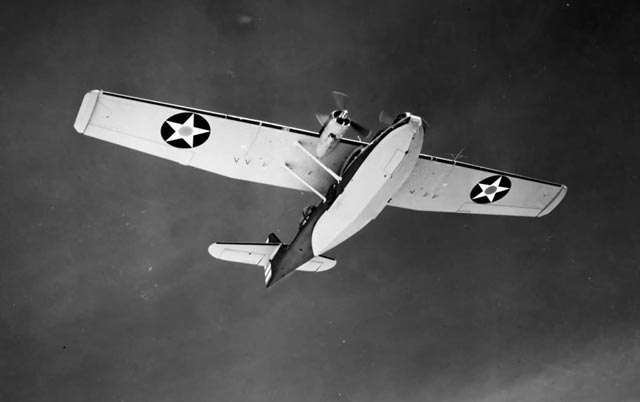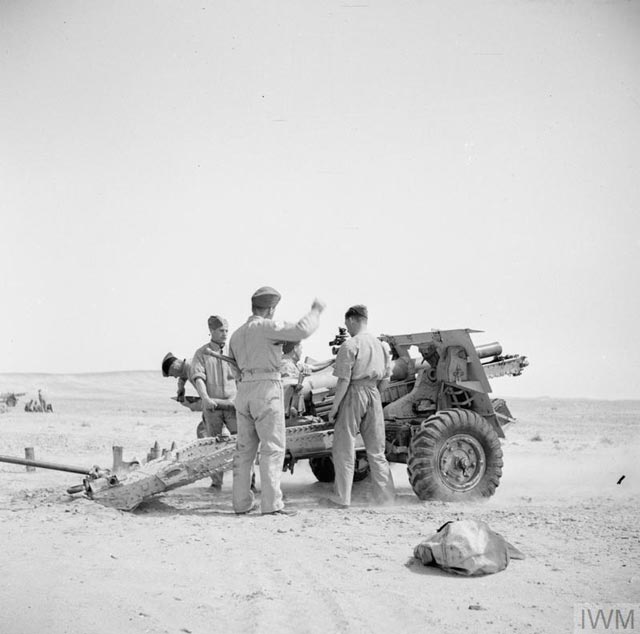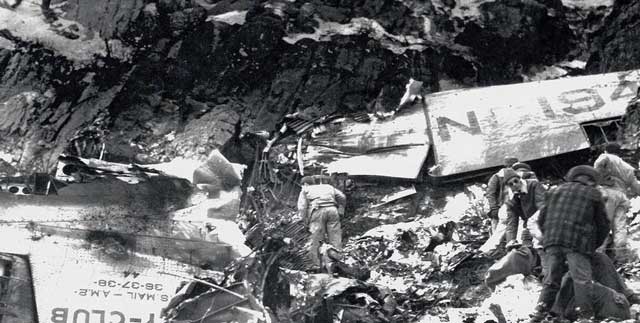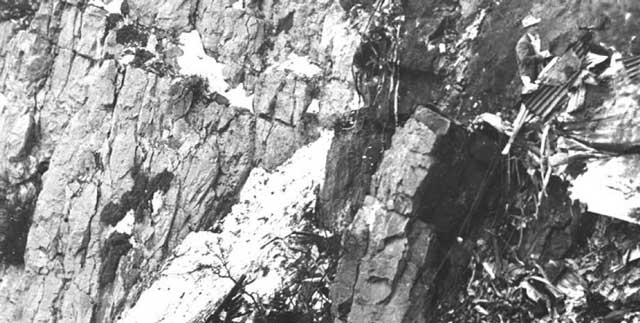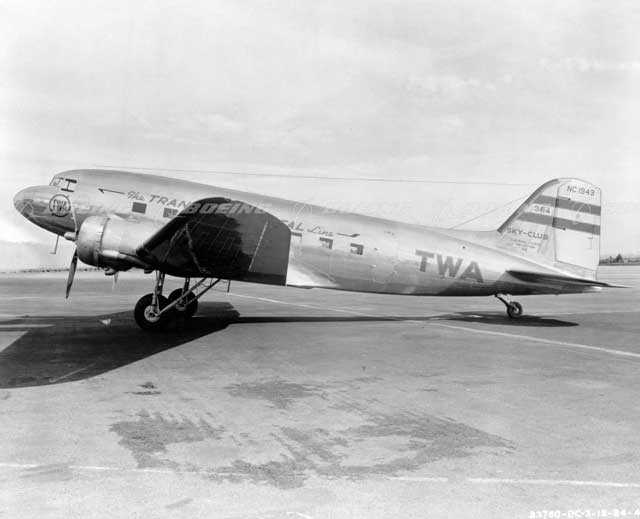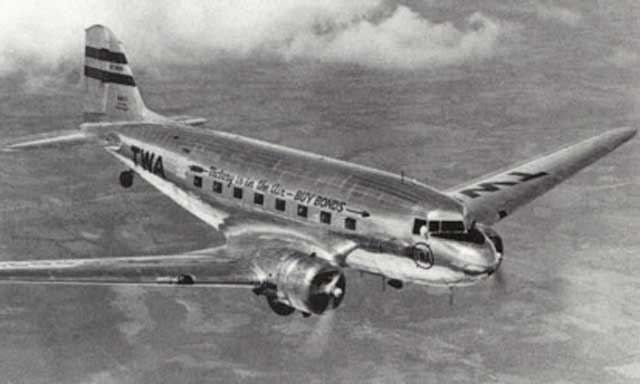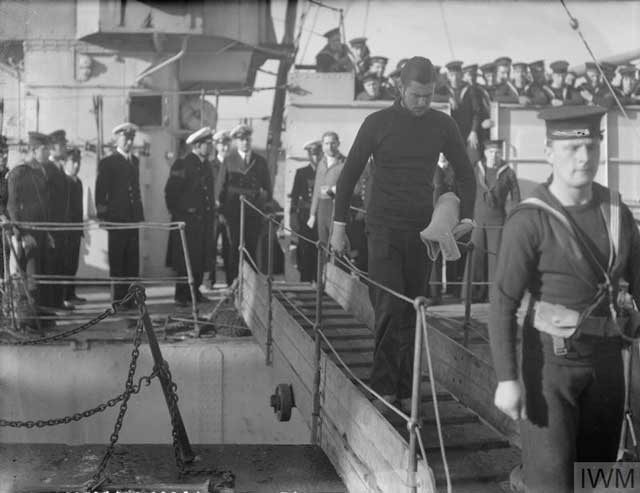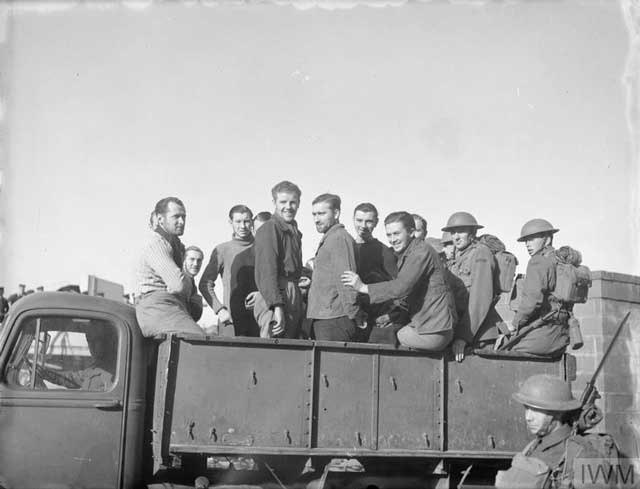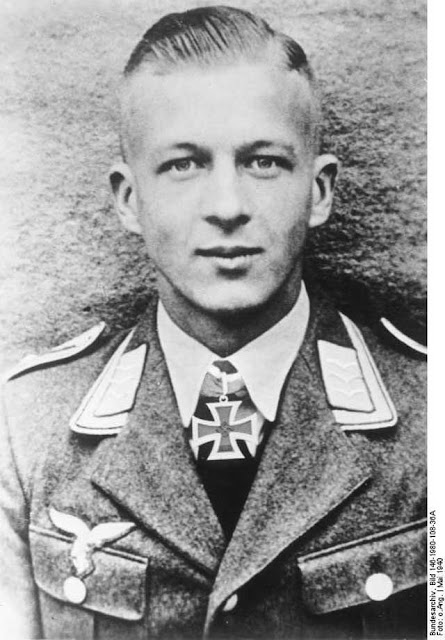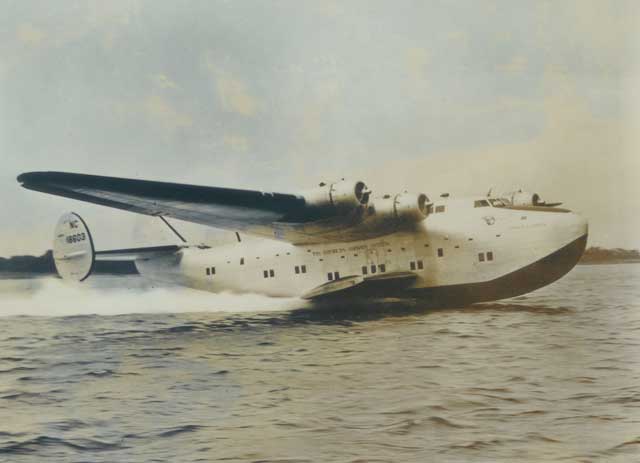Friday 13 February 1942
 |
| Imperial Japanese Army paratrooper landing to start the battle of Palembang, February 13, 1942. |
Battle of the Pacific: The situation at Singapore becomes critical on
13 February 1942. The British have pulled back into a 28-mile perimeter around Singapore City in the eastern portion of Singapore Island, but to date, the Allies have not been able to do more than slow the Japanese down. At around 14:00, the Japanese 18th Division attacks the part of this line held by the Malay Regiment. This attack begins the Battle of Pasir Panjang. The Japanese have tank and artillery support and immediately push part of the regiment, B Company, back. This develops into hand-to-hand combat.
 |
| Japanese paratroopers landing in Sumatra, Dutch East Indies, 13 Feb 1942 (Japanese Navy photo). |
The Malay unit is destroyed, the Japanese capture or kill most of the men, and nearby sections of the line held by the 44th Indian Brigade and the 1st Malay Brigade also are forced to retreat after dark. The new line is anchored at Mount Echo and Depot Road (Buona Vista). Meanwhile, the Japanese re-establish the road over the causeway, dramatically improving their supply situation.
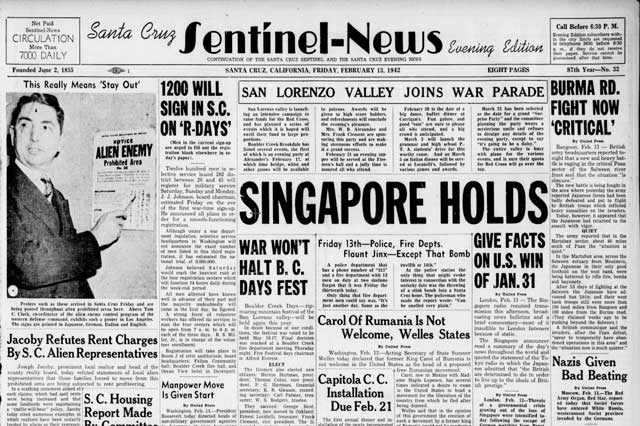 |
| The Santa Cruz (California) Sentinel-News, 13 February 1942, puts "Singapore Holds" as its main headline. |
While it is no longer safe for large vessels to enter or exit Singapore Harbor, many people are fleeing the island on small watercraft. Japanese ships move into position north of Bangka Island in an effort to block their exit. Among these is a launch carrying Rear-Admiral Spooner, Rear Admiral, Malaya, and Air Vice-Marshal Pulford, Air Officer Commanding, Far East. The Japanese ships force their launch to go ashore on a tiny island north of Bangka Island. The crew eventually surrender, but the two flag officers disappear and are never seen again.
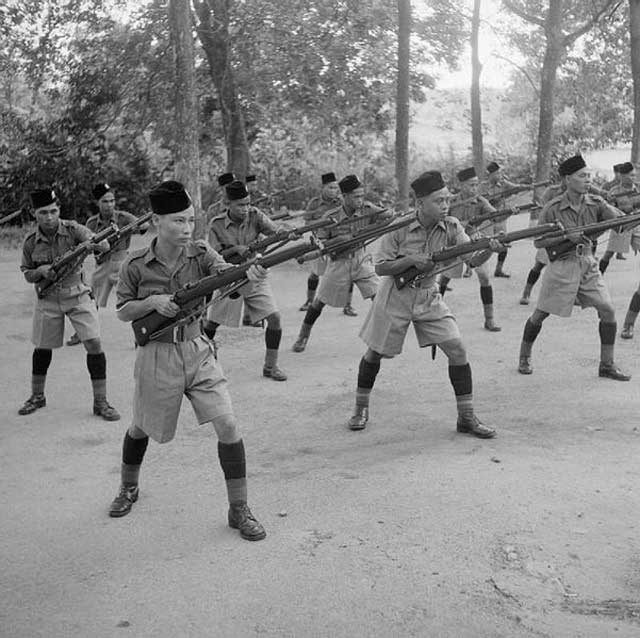 |
| The Malay Regiment at bayonet practice, October 1941. They are a key part of British defenses around the city of Singapore on 13 February 1942. © IWM (FE 414). |
Allied planes spot Japanese ships approaching Sumatra, which is the site of major Allied bases, and send planes to attack them. HMS Li Wo, a riverboat commandeered by the British Royal Navy that has been ferrying personnel between Singapore and the East Indies, blunders into the Japanese fleet. In a desperate action that concludes with the Li Wo trying to ram the nearest transport, the crew of the Li Wo damages several of the Japanese transports before the Japanese destroy their ship. Royal Navy Lieutenant Thomas Wilkinson, commander of the Li Wo, posthumously receives the only Victoria Cross awarded in the East Indies campaign.
 |
| HMS Tempest broaches the surface while being sunk by Italian gunboat Circe on 13 February 1942 (Difesa Online). |
While these actions are taking place offshore, the Japanese use Kawasaki Ki-56 transport planes of the 1st, 2nd and 3rd Chutai, Imperial Japanese Army Air Force (IJAAF) to drop Teishin Shudan (Raiding Group) paratroopers over Pangkalan Benteng airfield. Along with them come Mitsubishi Ki-21 bombers from the 98th Sentai to drop supplies for the paratroopers. The Japanese quickly seize the Pladjoe oil refinery complex undamaged. Seizing oil resources is a major Japanese war objective. Dutch troops quickly counterattack and retake the oil complex while suffering heavy losses. They manage to destroy part of the complex before being forced to withdraw with the arrival of 60 more Japanese paratroopers. This is considered the beginning of the Battle of Palembang.
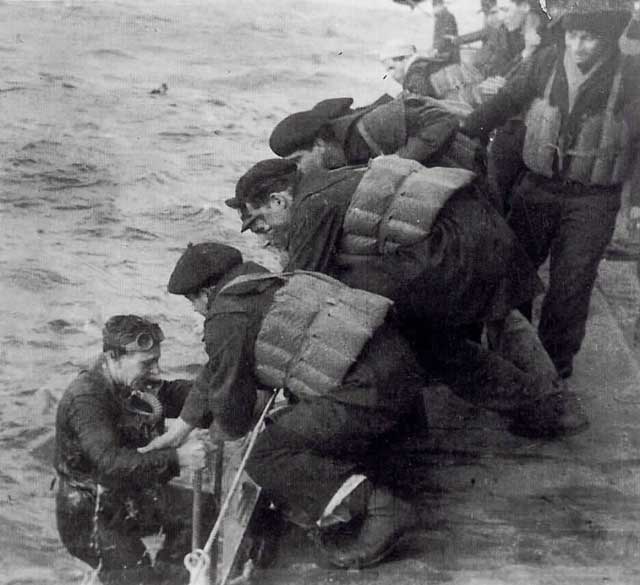 |
| Italian sailors on board the Circe rescue a British sailor from HMS Tempest on 13 February 1942. Note the Davis breathing apparatus that the man is wearing. |
Unlike elsewhere in both the European and Pacific Theater of Operations, it is a very good day for the Allies in the Philippines. The Allies eliminate the Japanese "Big Pocket" in the 1 Corps sector in the western half of the Bataan Peninsula. The remaining Japanese melt away into the jungle through a gap in the northern portion of the line. The Allies now are free to turn their full attention to the "Upper Pocket," which is a Japanese salient into the Main Line of Resistance (MLR) across the Pilar River. In addition, further south in the South Sector, the Allies eliminate another pocket of Japanese troops in the Silaiim area. These are the first major successes by the United States and allied forces in the Philippines and, at least on the ground in the Pacific Theater, in the war.
 |
| SS President Taylor, shown after her loss on 13 February 1942. |
In the Phoenix Islands, cargo liner 21,000-ton SS President Taylor, requisitioned for war service in December 1941, is carrying about 1100 soldiers and their artillery to the Canton (Kanton) Island garrison when it runs aground. The ship is landing its passengers when it drifts onto a well-known coral reef. This apparently happens because the ship either loses its anchor or it fails to hold. The ship is unloaded and tugs are sent to pull the Taylor off the reef. Great effort is expended to save the ship over the course of several months. These efforts ultimately are unsuccessful and the ship eventually is declared a total loss on 2 May 1942.
The USAAF Fifth Air Force sends 11 B-17 Flying Fortresses based on Java against Japanese shipping in the Makassar Strait. Ten bombers complete the mission, but the weather is cloudy and they claim a hit on only one ship.
 |
| SS President Taylor is visible in the background after her grounding on 13 February 1942. |
The Allied high command in the Pacific is beginning to realize the dangers in the region, which is leading to an abundance of caution. Australian Lieutenant General John Lavarack, General Officer Commanding 1st Australian Army, informs General Sir Archibald Wavell, Commander in Chief ABDA Command, that it would be unwise to land the Australian Imperial Force (AIF) in the Netherlands East Indies due to the danger to the Allies' position there. Wavell basically agrees and recommends to his superiors, the Combined Chiefs of Staff and the British and Australian War Offices, that there are "advantages in diverting one or both divisions of the AIF to Burma or Australia."
 |
| The 5424-ton British freighter SS Subadar, sunk by Japanese bombers off the Southern entrance to the Banka Strait on 13 February 1942. There are 65 survivors and 13 deaths. |
Eastern Front: A renewed Soviet offensive south of Lake Ilmen makes little progress. However, to some extent, this tightens the Red Army grip on the Demyansk Pocket. The Luftwaffe airlift to the pocket by Luftflotte 1 is hampered by poor weather, but that is beginning to improve. Luftflotte 1 is able to supply about half of the Demyansk Pocket's daily needs by using all of its transport capability and some bomber units. German troops in the pocket are fighting desperately to hold their perimeter and also hold open the "Ramushevo corridor," a hazardous route north to Staraya Russa.
On the Crimea, both sides are building up their forces for attempts to evict the other side. Joseph Stalin and Stavka representative Lev Mekhlis wished to launch an attack today from the Red Army line at the Parpach Narrows, but the buildup of troops and supplies has been inadequate. The offensive is postponed to later in February.
 |
| "Flying Officer John G. Gorton (indicated by the arrow), later Prime Minister of Australia, among survivors from the torpedoed Merchant Ship SS Derrymore (4,799 tons) who are being taken aboard HMAS Ballarat. The survivors, numbering 215, included 189 British Airmen." Derrymore was a 4799-ton ammunition ship which was torpedoed by HIJMS I-55 on 13 February 1942 (some sources say 12 February). Australian War Memorial 126196. |
European Air Operations: The RAF sends 85 bombers on missions after dark, but they achieve little. RAF Bomber Command sends 39 bombers to attack Cologne, 18 to bomb Aachen, and 28 to bomb Le Havre. Cloudy weather and icing force most of the force to return without bombing the targets. There are no losses.
 |
| Minesweeper HMS Young Cliff "About to drop the gate part of the sweeping gears," Granton, Scotland, 13 February 1942 (© IWM (A 7392)). |
Battle of the Atlantic: At 07:00, German heavy cruisers Gneisenau and Prinz Eugen reach Wilhelmshaven, followed at 10:00 by heavy cruiser Scharnhorst. This successfully completes Operation Cerberus, the famous Channel Dash. Gneisenau has been damaged by one magnetic mine which caused relatively minor damage, but Scharnhorst has been seriously damaged by two mines and barely makes it to port on one engine. A triumphant Admiral Otto Ciliax, in charge of the operation, sends a victory signal to Admiral Saalwächter in Paris:
It is my duty to inform you that Operation Cerberus has been successfully completed.
There are many ways to view the Channel Dash, and it is possible to say that the British "won" because the large ships no longer threatened Allied shipping in the Atlantic.
 |
| The Channel Dash is front-page news around the world. Here it is the main topic in The Springfield (Massachusetts) Union, 13 February 1942. |
However, just as Hitler has hoped, the Channel Dash operation is a major propaganda victory for the Reich. It also accomplishes his objective of getting the ships through the English Channel and back to Germany, though which side that may benefit in the long run is a little less clear. The British myth of invincibility in the Channel has been shattered for the time being. The fate of the ships themselves, which now no longer pose a serious threat to the outcome of the war at sea, is secondary to the Reich's proven ability to accomplish a difficult objective literally under the gaze of the British Royal Navy. The Luftwaffe, too, shares in the honors, having proven that it still can control disputed airspace over the Channel (the RAF loses 35 aircraft, including 16 fighters, and the Luftwaffe loses 22 fighters). The Channel Dash is a welcome tonic to German public opinion during a difficult winter.
 |
| Dummy tanks, mounted on trucks, being taken by the British to the front in North Africa, 13 February 1942 (© IWM (E 8361)). |
Battle of the Mediterranean: Italian torpedo boat Circe attacks and sinks British submarine HMS Tempest in the Gulf of Taranto after sighting it on the surface. The Italian attack begins with depth charges, which force the submarine to surface. The Circe then uses its 4-inch guns to finish the attack. There are 24 survivors (one later dies of wounds) picked up by the Circe, and 38 men perish.
US/Canadian Relations: The United States and Canada agree to the construction of a U.S. military highway through Canada to Alaska. This is to be completed as soon as possible and will become known as the ALCAN Highway. The road idea has been kicking around within the United States government since the 1920s, but the Canadian government has refused to agree to any joint funding. The war situation, however, has produced a positive change in attitude in Ottawa. Both countries have proposed routes, but the route chosen is a third option, "Route C," aka the Prairie option, that has been developed by the United States Army Corps of Engineers. Construction is scheduled to begin on 8 March 1942 and be completed before winter.
 |
| Aboard minesweeper HMS Young Cliff, "Gunner Jim Crow keeping a sharp look-out for enemy aircraft." 13 February 1942. © IWM (A 7382). |
Chinese/British Relations: Chinese Nationalist leader Chiang Kai-shek visits the Khyber Pass.
Norwegian/German Relations: Norwegian puppet leader Vidkun Quisling visits his patron, Adolf Hitler, in Berlin, along with Reich Commissioner in Norway Terboven.
Australian Military: The 39th Battalion completes the laying of about 40 km of telephone lines around Port Moresby because the high command believes that it will soon be attacked by the Japanese.
 |
| British Picture Sheet No. 29. Issued by Information Officer P.O. Box 384, Salisbury, 13 February 1942 (© IWM (Art.IWM PST 15679)). |
US Military: Vice Admiral William "Bull" Halsey Jr.'s naval task force, centered around aircraft carrier
USS Enterprise, is ordered to sortie out of Pearl Harbor today for an attack on remote Wake Island. This is not a particularly dangerous mission and is more important for pilot training than anything else. However, Halsey has a problem with this order, refuses to follow it as written, and demands that it be changed. The legend, which appears to be true, states that Halsey demands this change because of Triskaidekaphobia, or fear of the number 13. First, Halsey does not like that his task force is now Task Force 13. Second, Halsey refuses to leave port today, a Friday the 13th, especially in Task Force No. 13. Halsey demands that the task force be renumbered to Task Force No. 16 and that its departure for Wake Island be delayed. Halsey is perhaps the only United States hero of the war so far, and his slogan, "Hit hard, hit fast, hit often" has spread throughout the entire US Navy. So, Halsey's concerns are not to be trifled with. The change in the task force number is immediately approved by Soc McMorris, Admiral Nimitz's war plans officer, and the task force's departure is delayed until Saturday the 14th.
The 5th Air Force continues reorganizing its forces to meet the new realities in the Pacific Theater of Operations. The air echelon of the 88th Reconnaissance Squadron, 7th BG (Heavy), flies its B-17 Flying Fortresses into Nandi Airport on Fiji from Hawaii.
 |
| Port construction at Loch Ryan, Scotland, 13 February 1942 (© IWM (H 17198)). |
German Military: Using the brilliant success of the Channel Dash as cover, the Germans formally cancel Operation Sealion, the projected invasion of Great Britain. Planning for this operation has been dormant since September 1940. All units allocated for deployment in the projected invasion are officially detached from the project and made available for other operations. Hitler's thoughts quickly turn toward a defensive posture in the West, as evidenced by his 23 March 1942 Fuhrer Directive setting in motions plans for a "West Wall" on the Atlantic Coast.
Grand Admiral Erich Raeder, whose "peripheral strategy" in the Mediterranean has produced positive results, meets with Adolf Hitler to discuss new proposals in the region. Raeder seeks to mount a major offensive in North Africa. This would entail eliminating the British position in Egypt and continuing on to the east. This, Raeder argues, would secure major oil supplies for the Reich and eventually lead to a junction of German and Japanese forces in India. As a preliminary to this massive operation, Hitler agrees to order Luftflotte 2 in the Mediterranean to subdue Malta. When informed of this proposed operation, Lieutenant General Erwin Rommel agrees that it is feasible.
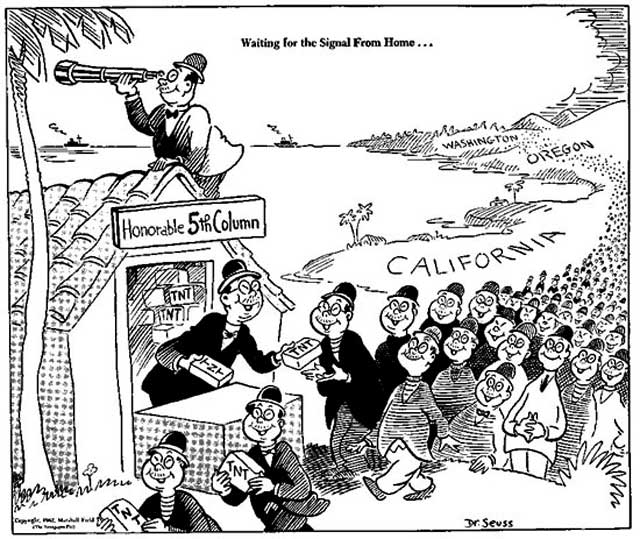 |
| Dr. Seuss cartoon, "Waiting for the signal from home," 13 February 1942 (Mandeville Special Collections Library, UC San Diego). |
US Government: The Pacific Coast Congressional subcommittee on aliens and sabotage adopts the following recommendations:
We recommend the immediate evacuation of all persons of Japanese lineage and all others, aliens and citizens alike, whose presence shall be deemed dangerous or inimical to the defense of the United States from all strategic areas.
In defining said strategic areas we recommend that such areas include all military installations, war industries, water and power installations, oil fields, and refineries, transportation, and other essential facilities as well as adequate protective areas adjacent thereto.
We further recommend that such areas be enlarged as expeditiously possible until they shall encompass the entire strategic area of the states of California, Oregon and Washington, and Territory of Alaska.
This is a key step in the internment of Japanese-Americans. The treatment of "all persons of Japanese lineage" is a hot topic throughout the United States government and in the public, too.
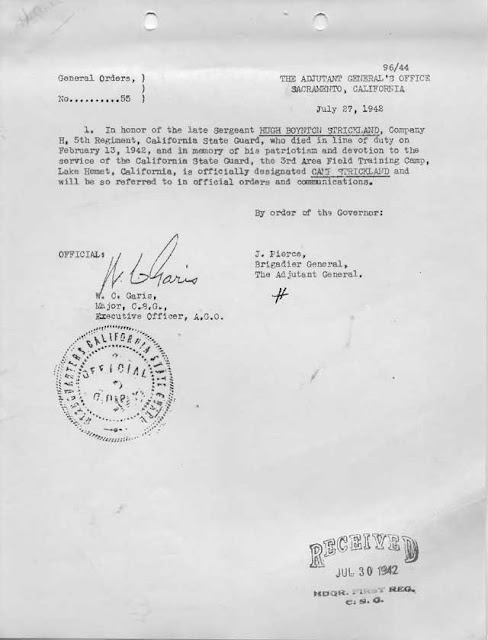 |
| Camp Strickland, a California State Guard Camp, receives its name on 27 July 1942 from California State Guard Sergeant Hugh Boyton Strickland, KIA on 13 February 1942. |
American Homefront: General John DeWitt, commander of the Fourth Army as well as the Western Defense Command of the United States Army, completes a memorandum for the Secretary of War, which he promptly forwards with a covering memorandum via airmail. He recommends the enforced evacuation by the federal authority of the American-born Japanese. This begins a very contentious review of how to treat American-born Japanese.
"Ride 'Em Cowboy" is released by Universal Pictures. It stars Bud Abbott and Lou Costello as peanut vendors who head West after getting into some trouble and get jobs as cowboys on a dude ranch. The film is notable for being filmed on two actual dude ranches, the B-Bar A and the Rancho Chihuahua. It also marks the film debut of Ella Fitzgerald. The film, directed by Arthur Lubin, is a smash hit at the box office. "Ride 'Em Cowboy" was actually shot in 1941, but Universal delayed its release because Abbott and Costello's other film "Keep 'Em Flying" was still doing well at the box office.
Future History: Peter Halsten Thorkelson is born in Washington, D.C. After growing up in Connecticut, Peter develops an interest in music and spends time playing the guitar and other stringed instruments in Greenwich Village. At some point, he changes his professional name to Peter Tork. While in New York, Tork meets Stephen Stills, a fellow fledgling musician. Stills auditions for a new television series about four young musicians, but fails to pass the audition. He recommends his friend Peter, and Tork gets the job. The new show is called "The Monkees" and is a smash hit, succeeding in both the television and pop music realms. Tork goes on to his own musical career in later years, though The Monkees reform several times over the years and even record new material in the 1980s. Peter Tork passes away on 21 February 2019 in Mansfield, Connecticut.
Carole Ann Jones is born in Manhattan, New York. She becomes a successful actress under the name Carol Lynley, appearing in numerous television series and making a big splash in "The Poseidon Adventure" (1972) as Nonnie Parry. Carol Lynley passes away on 3 September 2019 in Pacific Palisades, California.
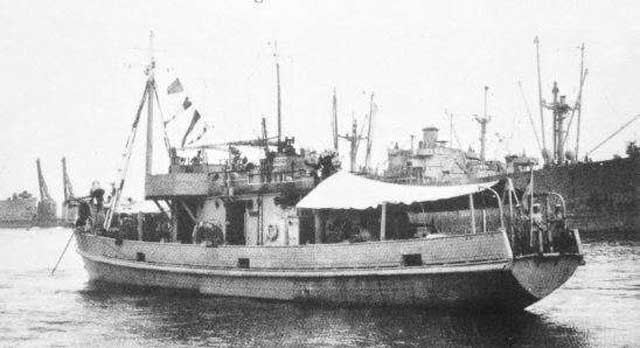 |
| British Royal Navy minesweeper MMS-180, sunk after a collision at the mouth of the River Tyne on 13 February 1942. Everyone survives. |
February 1942February 1, 1942: The US Navy Strikes BackFebruary 2, 1942: Germans Recovering in RussiaFebruary 3, 1942: Japanese Shell and Bomb SingaporeFebruary 4, 1942: Battle of Makassar StraitFebruary 5, 1942: Empress of Asia SunkFebruary 6, 1942: The Christmas Island BodyFebruary 7, 1942: The Double-V CampaignFebruary 8, 1942: Japan Invades SingaporeFebruary 9, 1942: French Liner Normandie CapsizesFebruary 10, 1942: US Car Production EndsFebruary 11, 1942: Tomforce Fails on SingaporeFebruary 12, 1942: The Channel DashFebruary 13, 1942: Japanese Paratroopers In ActionFebruary 14, 1942: RAF Orders Terror RaidsFebruary 15, 1942: Japan Takes Singapore
February 17, 1942: Indian Troops Defect to JapaneseFebruary 18, 1942: Battle of Badung StraitFebruary 19, 1942: FDR Authorizes Internment CampsFebruary 20, 1942: O'Hare the HeroFebruary 21, 1942: Crisis in BurmaFebruary 22, 1942: Bomber Harris Takes OverFebruary 23, 1942: Bombardment of Ellwood, CaliforniaFebruary 24, 1942: US Raid on Wake IslandFebruary 25, 1942: Battle of Los AngelesFebruary 26, 1942: Gneisenau EliminatedFebruary 27, 1942: Battle of Java SeaFebruary 28, 1942: Battle of Sunda Strait2020
